2012 Yamaha FX HO Review
Welcome Update Vastly Improves Base Model FX
Some big changes are afoot in Yamaha’s popular midrange FX HO for 2012. But don’t expect wholesale remodeling. Instead, Yamaha has put a great deal of thought into the changes behind its FX makeover.
And those changes make an already good boat even better.
Change Is Good
The modifications done to the FX series for 2012 address both form and function. In terms of the former, the boat’s overall look has gotten notably more aggressive, compliments of style elements that have been added to the deck in strategic spots. Though their seamless appearance wouldn’t tip you off, most of these pieces are actually bolted to the former deck.
In some areas, Yamaha takes full advantage of that fact and provides a functional addition. At the stern, a more angular piece added over the formerly rounded section beneath the seat has allowed the manufacturer to add a clever wet stowage compartment, perfect for keeping a ski rope or maybe a snorkel and mask. The door is even notched to allow a towrope to be stored while still attached to the tow eye.
Those enjoying time at the end of that towrope will appreciate a redesigned boarding step. It’s flat profile is easier on bare feet, and its deeper reach doesn’t require so much “muscling” to haul yourself aboard. A new handle in the deck adds to the ease of boarding, allowing riders to climb their way back aboard. Nearly eight additional inches in the craft’s length also helps, with over four inches added to the platform.
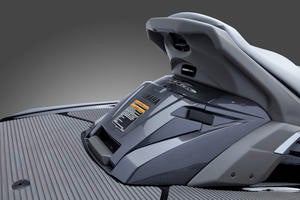 New dual grab handles make reboarding quicker and easier.
New dual grab handles make reboarding quicker and easier.Perhaps the biggest mechanical change is a new neutral setting in the reverse lever. It’s not an electronic enhancement, but instead a physical detent in the throw of the lever, marked by an N setting in a small window on the lever itself. Click the lever into neutral and the reverse bucket partially deploys, deflecting water to prevent most forward or backward movement. This simple solution works quite well, allowing the driver to start the boat in a stationary position at the dock or ramp, then shift into forward or neutral. One catch? It’s still located on the starboard side of the console, meaning you won’t be able to easily use throttle and forward/neutral/reverse simultaneously.
One final change is also seen at the helm. The buttons that activate the display’s different modes have now been clustered into a group behind the handlebars. It eliminates the awkward reach required by the former design.
Same Engine, Better Ride
The HO is Yamaha’s most basic FX model, but it’s not underpowered. Under the seat is the lightweight 1.8-liter engine that debuted in the craft three years ago. It powers the HO to a top speed between 63-64 mph, and leaps to 30 mph in just over two seconds. That’s impressive speed, and more than up to the task of towing the skiers and wakeboarders in your life.
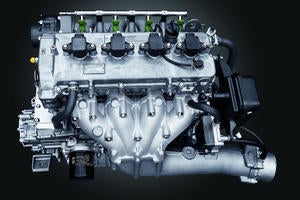 The 1.8-liter engine is capable of powerign the FX HO to speeds of 63-64 mph.
The 1.8-liter engine is capable of powerign the FX HO to speeds of 63-64 mph.That engine comes with electronic throttle. Alone, it provides even control of the engine by eliminating a physical cable, but users will most likely appreciate the features it makes possible. Cruise Assist is like the cruise control you find on your car. Find a speed, push the button, and the craft will maintain that speed and allow the driver to simply fully squeeze the throttle. The feature eliminates finger fatigue on extended rides, but is also a godsend for those who like to ski and wakeboard and don’t trust their driver to maintain a steady speed. A No-Wake mode also keeps the craft moving forward at a steady speed (approximately 5 mph) without requiring any pressure on the throttle.
While we’re speaking of ride, I found the tweaked hull (longer in length, new sponsons, and a new full-length keel) offered a better one than before at speed. Instead of falling on and off the pad as the former design could occasionally do in a turn, the ’12 version banked confidently into turns. It allowed me to carve up a glassy Georgia lake with the precision of a street bike on a twisty road. Adjustable handlebars help the driver get as low or high as they desire within a 20-degree arc to compliment their riding style. Manual trim, located on the left handlegrip, can drop the bow for cornering or acceleration, and raise it for high-speed runs.
Practical considerations? Riders can stow their gear in a large front tub, put drinks in the glovebox, and keep vital papers or other items in a watertight canister built into the console. Total storage capacity is just over 33 gallons. Yamaha offers an automotive-like take on security, giving the craft a keyfob that can activate or deactivate the ignition. That same control can govern the engine so that it peaks at a slower speed for less-experienced riders or to save fuel.
Better With Age
Obviously, there’s a lot to like about the new FX HO. New form, new functions, yet a familiar engine platform that oozes reliability and runs with some of the hottest machines on the market. My lasting impression, however, is one of fun. While all those features may be cool, a craft’s ride is still its most important offering.
And with its newfound precision and grace in the turns, the FX HO ups the fun factor significantly.
| 2012 Yamaha FX HO Specs | |
| Length | 140.2 inches |
| Beam | 48.4 inches |
| Dry Weight | 822 lbs |
| Engine | Four-cylinder DOHC EFI |
| Displacement | 1,812 cc |
| Bore and Stroke | 86mm x 78mm |
| Compression Ratio | 11.0:1 |
| Rated Horsepower | N/A |
| Fuel Capacity | 18.5 gal. |
| Combined Stowage Capacity | 33.2 gal. |
| Colors | Eclipse Black |
| Price | $12,499.00 |
Related Reading
2012 Yamaha FX Cruiser HO Review
2012 Yamaha FZR Review
2012 Yamaha FZS Review
Yamaha FX HO Wins in its Racing Debut
Get PersonalWatercraft.com in your Inbox!
Like PersonalWatercraft.com on Facebook
Comments
Most Popular

2025 Yamaha JetBlaster PRO 2-Up Review

2024 Kawasaki Jet Ski STX 160X Review

Remembering the Sea-Doo XP

Whatever Happened to the Wetbike?

2025 Yamaha JetBlaster Review




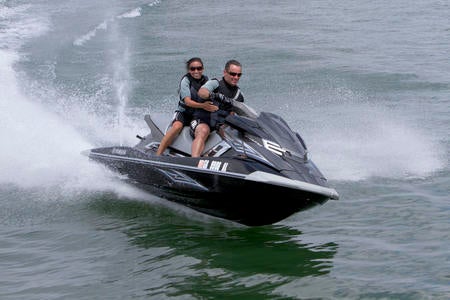
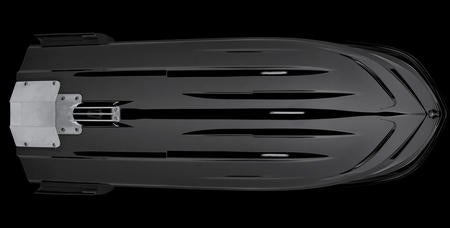
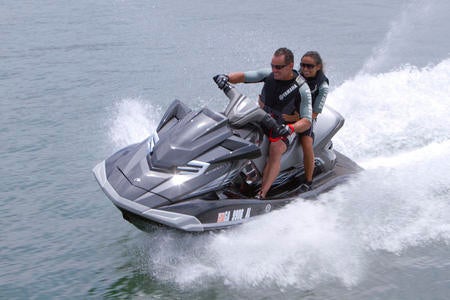







 Your Privacy Choices
Your Privacy Choices